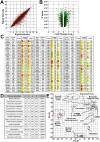Core Transcription Factors, MicroRNAs, and Small Molecules Drive Transdifferentiation of Human Fibroblasts Towards The Cardiac Cell Lineage
- PMID: 28071742
- PMCID: PMC5223186
- DOI: 10.1038/srep40285
Core Transcription Factors, MicroRNAs, and Small Molecules Drive Transdifferentiation of Human Fibroblasts Towards The Cardiac Cell Lineage
Abstract
Transdifferentiation has been described as a novel method for converting human fibroblasts into induced cardiomyocyte-like cells. Such an approach can produce differentiated cells to study physiology or pathophysiology, examine drug interactions or toxicities, and engineer cardiac tissues. Here we describe the transdifferentiation of human dermal fibroblasts towards the cardiac cell lineage via the induced expression of transcription factors GATA4, TBX5, MEF2C, MYOCD, NKX2-5, and delivery of microRNAs miR-1 and miR-133a. Cells undergoing transdifferentiation expressed ACTN2 and TNNT2 and partially organized their cytoskeleton in a cross-striated manner. The conversion process was associated with significant upregulation of a cohort of cardiac-specific genes, activation of pathways associated with muscle contraction and physiology, and downregulation of fibroblastic markers. We used a genetically encoded calcium indicator and readily detected active calcium transients although no spontaneous contractions were observed in transdifferentiated cells. Finally, we determined that inhibition of Janus kinase 1, inhibition of Glycogen synthase kinase 3, or addition of NRG1 significantly enhanced the efficiency of transdifferentiation. Overall, we describe a method for achieving transdifferentiation of human dermal fibroblasts into induced cardiomyocyte-like cells via transcription factor overexpression, microRNA delivery, and molecular pathway manipulation.
Figures







References
-
- Davis R. L., Weintraub H. & Lassar A. B. Expression of a single transfected cDNA converts fibroblasts to myoblasts. Cell 51, 987–1000 (1987). - PubMed
Publication types
MeSH terms
Substances
LinkOut - more resources
Full Text Sources
Other Literature Sources
Molecular Biology Databases
Research Materials
Miscellaneous

